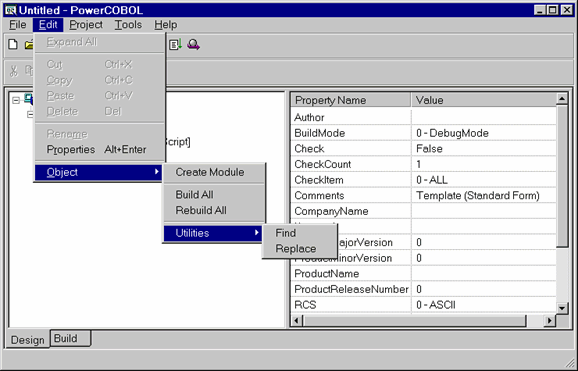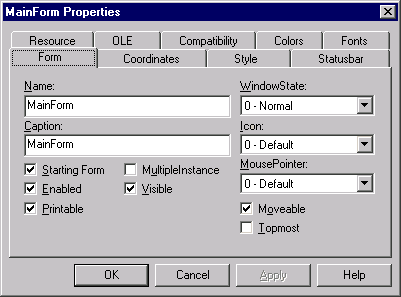The Edit menu appears only if you have a project currently open
The Edit menu appears only if you have a project currently open and gives you access to functions in the PowerCOBOL Project Manager that may assist you in shaping the design of your application. Accessibility to functions in the Edit menu varies depending on what type of application component you have currently selected in the left windowpane. Note that the Edit menu only appears when you have a project loaded in PowerCOBOL.
The Edit menu appears as follows:
Figure 2.5 The PowerCOBOL Project Manager Edit menu

The Edit menu contains the following functions:
Expands the project hierarchy to show all levels of the tree.
Removes the selected application component and stores it on the clipboard. At the next Cut or Copy command, the selection is erased from the clipboard.
Copies the selected application component to the clipboard without removing the selection from the current project definition.
Places the clipboard contents into the current project under the appropriate managing component in the hierarchical project tree. For example, if you have copied a form (window) and wish to insert it into the current project to create a separate identical form, you would insert this new form directly under the application module that will control the form. Note: The Paste command usually follows the Copy or Cut command.
Removes the selected application component from the current project definition.
Renames the selected application component in the current project definition.
Displays the Properties dialog box for the currently selected application component. This dialog box allows you to examine and modify properties similar to the Properties list in the right windowpane. The Properties dialog box differs from the Properties list in that it organizes related properties, whereas the Properties list presents all properties in alphabetical order. The Properties dialog box appears as follows:
Figure 2.6 The Form Properties dialog box

A number of sub options are available from the Object selection on the Edit pull down menu. You may also right click on any object in the Project Manager Hierarchy and a context menu will appear containing options. The options found in the Edit->Object menu change dynamically depending upon the type of application object currently selected (highlighted) in the Project Manager hierarchy as noted below:
Figure 2.5 above shows the Edit->Object menu expanded for a Project (e.g. when the actual project name is currently selected in the Project Manager hierarchy). The options available include:
Allows you to add a new executable module definition in your project. PowerCOBOL projects can create one or more executable modules.
Builds the project, compiling and linking only components that were changed.
Rebuilds (compiles and links) all application components, regardless as to whether they were modified.
Brings up the Find and Replace utility context menu. These utilities allow you to search through an entire project looking for search strings you may specify, and to optionally replace the search string with a new string.
Expands the entire project hierarchy.
Brings up the Properties dialog box for the item currently selected in the project hierarchy.
When you select (highlight) an executable Module in the Project Manager hierarchy and select the Edit->Object menu, the following options are available to you:
Creates a new form in the module.
Allows you to insert an external file into the current PowerCOBOL project. External files supported are COBOL programs, Object files (.OBJ), Library files (.LIB), Bitmap files (.BMP), Icon files (.ICO), Cursor Files (.CUR), Image Lists (.BMP), Animate Cursor files (.ANI). If your executable module required the static linking of an external .OBJ or .LIB file that had been created outside of PowerCOBOL, for example, this is the option you would use to add it into your project.
Invokes the Build facility.
Invokes the Rebuild facility.
Invokes the PowerCOBOL Debugger on the currently select module
Executes the currently selected module.
Registers the currently selected module in the Windows Registry (invokes the Windows Regsvr32.exe utility).
Unregisters the currently selected module from the Windows Registry (invokes the Windows Regsvr32.exe utility).
Brings up the utilities context menu containing the Find and Replace utilities.
Expands the Project Manager Hierarchy completely under the currently selected module.
Standard Windows cut, copy paste and delete operations.
Allows you to rename the currently selected module.
Brings up the module's Properties dialog box.
When you select (highlight) a Form in the Project Manager hierarchy and select the Edit->Object menu, the following options are available to you:
Opens the currently selected Form in the PowerCOBOL Form Editor, allowing you to modify it.
Compiles the currently selected Form. Note that "under the covers", PowerCOBOL creates a separate program for each Form defined in a module. A PowerCOBOL executable Module is made up of one or more Forms compiled and linked together.
Allows you to modify the SPECIAL-NAMES, REPOSITORY, and FILE-CONTROL sections of the ENVIRONMENT DIVISION of the currently selected form. The FILE-CONTROL section is where you would place SELECT....ASSIGN TO statements to define an external data file to be accessed from a Form, for example.
Allows you to modify the BASED-STORAGE, FILE, WORKING-STORAGE, and CONSTANT sections of a Form. The FILE section, for example, is where you would place FD statements and associated record definitions for external data file definitions to be accessed from the Form The WORKING-STORAGE section is where you would define COBOL data items for the Form. Note that if you want to share these data definitions (both FD's and WORKING-STORAGE section items with event procedures in your Form, you must specify the IS GLOBAL optional phrase on each such definition. To share these definitions across separate executable modules, you must specify the optional IS EXTERNAL phrase on each such definition.
Allows you to create COBOL programs (scriptlets) that are not tied to any particular event and may be called from other event procedures or scriptlets. If you wanted to create a program to format dates for example and wanted to call it from several different places in your PowerCOBOL application, this is where you would define it. You create a new scriptlet by selecting the New option that appears. The PROCEDURE option allows you to specify declaratives and SQL cursor definitions so that they get executed firth when the form is initialized.
Shows a list of all of the event procedures that are available for the Form, and allows you to edit them. Event procedures are individual COBOL programs (also called "scriptlets") that you write to handle specific events, such as when a user clicks the mouse on a specific command button. The list presented her, however, are event procedures associated with the form itself - not the controls that you may have placed on the form. For example, you might want to use the "Opened" to write initialization code, as it gets triggered when the form is opened. If you see an asterisk character to the left of one of the event procedures in the context menu that appears, it designates that an event procedure currently exists for that event.
Previews the currently selected Form. This brings the form up on the desktop as it will look at execution time.
Allows you to define the tab order of controls on the form.
Allows you to create a custom property for the form and to define its data type.
Allows you to create a custom method and define its parameter usage.
Allows you to create a custom event.
Allows you to create or modify a menu for the form.
Allows you to print information regarding the form.
Brings up a child menu from which you can access the Find and Replace utilities.
Expands the entire project hierarchy.
Standard Windows Cut function.
Standard Windows Copy function.
Standard Windows Paste function.
Standard Windows Delete function.
Allows you to rename the form.
Brings up the form's Properties dialog box.
When you select (highlight) the Script(COBOL Script) entry in the Project Manager hierarchy and select the Edit->Object menu, the following options are available to you:
Allows you to print the source code of existing event procedures.
Brings up the utilities context menu allowing access to the Find and Replace utilities.
Compiles the event procedures.
Allows access to the form's ENVIRONMENT DIVISION sections.
Allows access to the form's DATA DIVISION sections.
Allows access to the form's PROCEDURE DIVISION.
Brings up the Properties dialog box for the currently selected item in the project hierarchy.